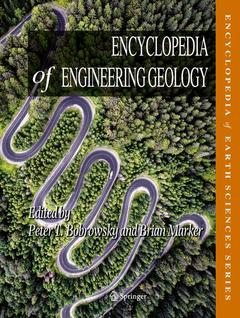Encyclopedia of Engineering Geology, 1st ed. 2018 Encyclopedia of Earth Sciences Series
Coordonnateurs : Bobrowsky Peter T., Marker Brian

This volume addresses the multi-disciplinary topic of engineering geology and the environment, one of the fastest growing, most relevant and applied fields of research and study within the geosciences. It covers the fundamentals of geology and engineering where the two fields overlap and, in addition, highlights specialized topics that address principles, concepts and paradigms of the discipline, including operational terms, materials, tools, techniques and methods as well as processes, procedures and implications.
A number of well known and respected international experts contributed to this authoritative volume, thereby ensuring proper geographic representation, professional credibility and reliability. This superb volume provides a dependable and ready source of information on approximately 300 topical entries relevant to all aspects of engineering geology. Extensive illustrations, figures, images, tables and detailed bibliographic citations ensure that the comprehensively defined contributions are broadly and clearly explained.The Encyclopedia of Engineering Geology provides a ready source of reference for several fields of study and practice including civil engineers, geologists, physical geographers, architects, hazards specialists, hydrologists, geotechnicians, geophysicists, geomorphologists, planners, resource explorers, and many others. As a key library reference, this book is an essential technical source for undergraduate and graduate students in their research. Teachers/professors can rely on it as the final authority and the first source of reference on engineering geology related studies as it provides an exceptional resource to train and educate the next generation of practitioners.
Abrasiveness.- Accreditation.- Acidity (pH).- Acid mine drainage.- Aeolian processes.- Aerial photography.- Aeromagnetic survey.- Aggregate.- Aggregate tests.- Alkali silica reactivity.- Alluvial environments.- Alteration.- Anchoring.- Angle/area of influence.- Angle of internal friction.- Aquifer.- Aquitard.- Armour stone.- Artesian.- Artificial ground.- Atterburg Limits.- Avalanche.- Backfill.- Beach replenishment.- Bearing capacity.- Bedrock.- Biological weathering.- Blasting.- Borehole.- Borehole investigations.- Boulders.- Breakwaters.- Bridges.- Brownfield sites.- Building/dimension stone.- Bulk modulus.- California bearing ratio.- Cambering.- Cantilever.- Capillarity.- Cap rock.- Casagrande test .- Casing.- Catchment.- Cement.- Characterization of soils.- Chemical weathering.- Chezy formula .- Classification of rocks.- Classification of soils.- Clay.- Climate change.- Coal.- Coastal environments.- Cobbles.- Coefficient of uniformity.- Coffer dams.- Cohesive soils.- Collapsingsoils.- Compaction.- Compression.- Compressive soils.- Concrete.- Conductivity.- Cone penetrometer.- Consolidation.- Contamination.- Corestones.- Corrosion.- Cross-Section.- Crushed rock.- Current action.- Cut and cover.- Cut and fill.- Cut off trench.- Dams.- Darcy’s Law.- Deformation.- Demolition.- Density.- Deposition.- Desert environments.- Designing site investigations.- Dessication.- Deviatoric stress.- Dewatering.- Diagenesis.- Dilatancy.- Dispersivity.- Drainage.- Drilling.- Drilling hazards.- Durability.- Dyke.- Dynamic compaction/compression.- Earthquake.- Earthquake intensity.- Earthquake magnitude.- Effective stress.- Elasticity.- Embankments.- Engineering geological mapping.- Engineering geology.- Engineering geomorphological mapping.- Engineering geomorphology.- Engineering properties.- Environmental assessment.- Environments.- Equipotential lines.- Erosion.- Ethics.- Evaporites.- Excavation.- Expansive soils.- Extensometer.- Facies.- Factor of safety.- Failure.- Faults.- Fills.- Filtration.- Flooding.- Fluidization.- Fluid withdrawal.- Fluvial environments.- Foundations.- Gabions.- Gases.- Geochemistry.- Geological hazards.- Geological structures.- Geology.- Geophysical methods.- Geostatic stress.- Geotechnical engineering.- Geotextiles.- Geothermal energy.- GIS.- Glacial environments.- Gradation/grading.- Gravel.- Ground preparation.- Ground shaking.- Groundwater.- Groundwater rebound.- Grout/grouting.- Hazard.- Hazard assessment.- Health and safety.- Hooke’s Law.- Hydraulic action.- Hydraulic fracturing.- Hydrocompaction.- Hydrogeology.- Hydrology.- Hydrothermal alteration.- IAEG.- IAH.- Igneous rocks.- Inclinometer.- Induced seismicity.- Infiltration.- Infrastructure.- InSAR.- Instrumentation.- ISRM.- ISSMGE.- Jacking test.- Jetties.- Karst.- Kozeny-Carmen equation.- Lacustrine environments.- Landfill.- Landforms.- Land use.- Landslides.- Laplace equation.- Lateral pressure.- Levees.- LiDAR.- Limestone.- Liners.- Liquefaction.- Liquid limit.- Loess.- Logging.- Manning formula.- Marine environments.- Mass movement.- Mechanical properties.- Metamorphic rocks.- Mine closure.- Mineralization.- Mining.- Mining hazards.- Modelling.- Modulus of deformation.- Modulus of elasticity.- Mohr circle.- Mohr-Coulomb failure envelope.- Monitoring.- Mountain environments.- Near shore structures.- Neutral pressure.- Non-cohesive soils.- Normal stress.- Organic soils.- Peels.- Percolation.- Permafrost.- Petrographic analysis.- Physical weathering.- Piezometer.- Photogrammetry.- Pipes/pipelines.- Plasticity index.- Plastic limit.- Poisson’s ratio.- Pore pressure.- Positive pressure.- Probability.- Professional practice.- Pressure.- Quick clay.- Quick sand.- Reclamation.- Reduced stress.- Remote sensing.- Reservoirs.- Residual soils.- Retaining structures.- Risk assessment.- Risk mapping.- Rock bolts.- Rock field tests.- Rock laboratory tests.- Rock mass classification.- Rock mechanics.- Rock properties.- Run off.- Sabkha.- Saline soils.- Sand.- Saturation.- Sea level.- Sedimentary rocks.- Sediments.- Shale.- Shear modulus.- Shear strength.- Shear stress.- Shear zone.- Shotcrete.- Silt.- Sinkholes.- Site investigation.- Slurry trenches.- Soil field tests.- Soil laboratory tests .- Soil mechanics.- Soil nailing.- Soil properties.- Stabilization.- Strain.- Strength.- Stress.- Subsidence.- Subsurface exploration.- Surface rupture.- Surveying.- Swelling/shrinkage of clays.- Tailings.- Tension scars .- Testing.- Thermistor.- Tiltmeter.- Tropical environments.- Tunnels.- Vegetation cover.- Velocity ratio.- Vibrations.- Voids.- Volcanic environments.- Waste.- Waste management.- Water.- Water testing.- Wells.- Young’s modulus.
Peter Bobrowsky is a Research Scientist with the Geological Survey of Canada (Sidney, BC), and Adjunct Full Professor at Simon Fraser University (Burnaby, BC) and University of Victoria (Victoria, BC). He received his PhD in Geology in 1988 from the University of Alberta, Canada and formally registered with the BC Association of Professional Engineers and Geoscientists in 1992. During his 30 year career he has worked extensively in engineering geology with a primary emphasis on mineral resource studies (aggregates) and natural hazards (landslides, paleotsunamis). He was the President of the Geological Association of Canada, President of the Canadian Quaternary Association, Secretary General of IUGS and is currently the President of the International Consortium on Landslides.
Brian Marker received BSc and PhD degrees in Geology from the University of London, UK in 1968 and 1972 respectively. He became a Chartered Geologist in 1992. He worked for over 30 years for the UK Department of the Environment and its successor Departments advising on land use planning issues associated with minerals supply, natural hazards, contaminated land and waste management. Since retirement in 2006 he had been an independent consultant as well as serving as an Editorial Board member of the Bulletin of the IAEG, a Councillor of the Geological Society (London) and, since 2013, as Chairman of the IUGS Publications Committee.
Date de parution : 08-2018
Ouvrage de 978 p.
21x27.9 cm
